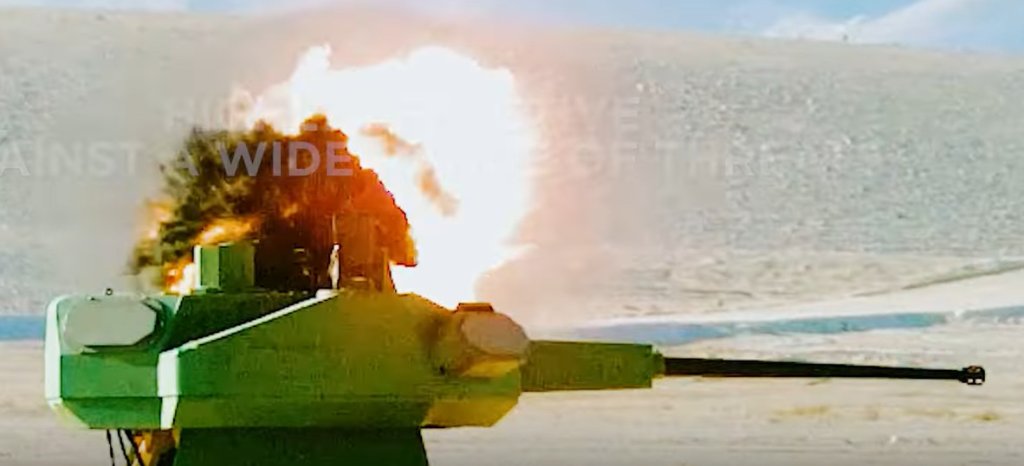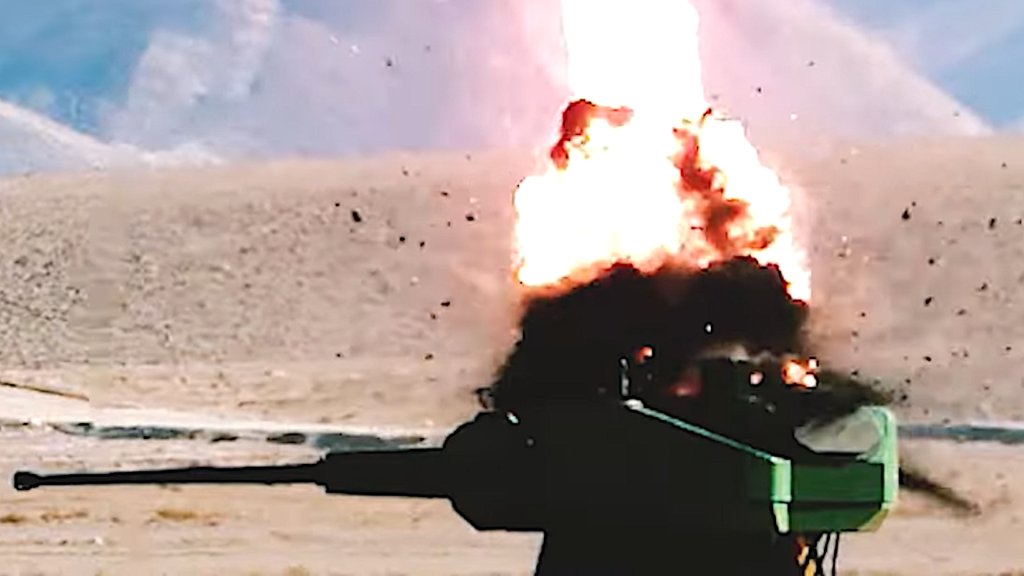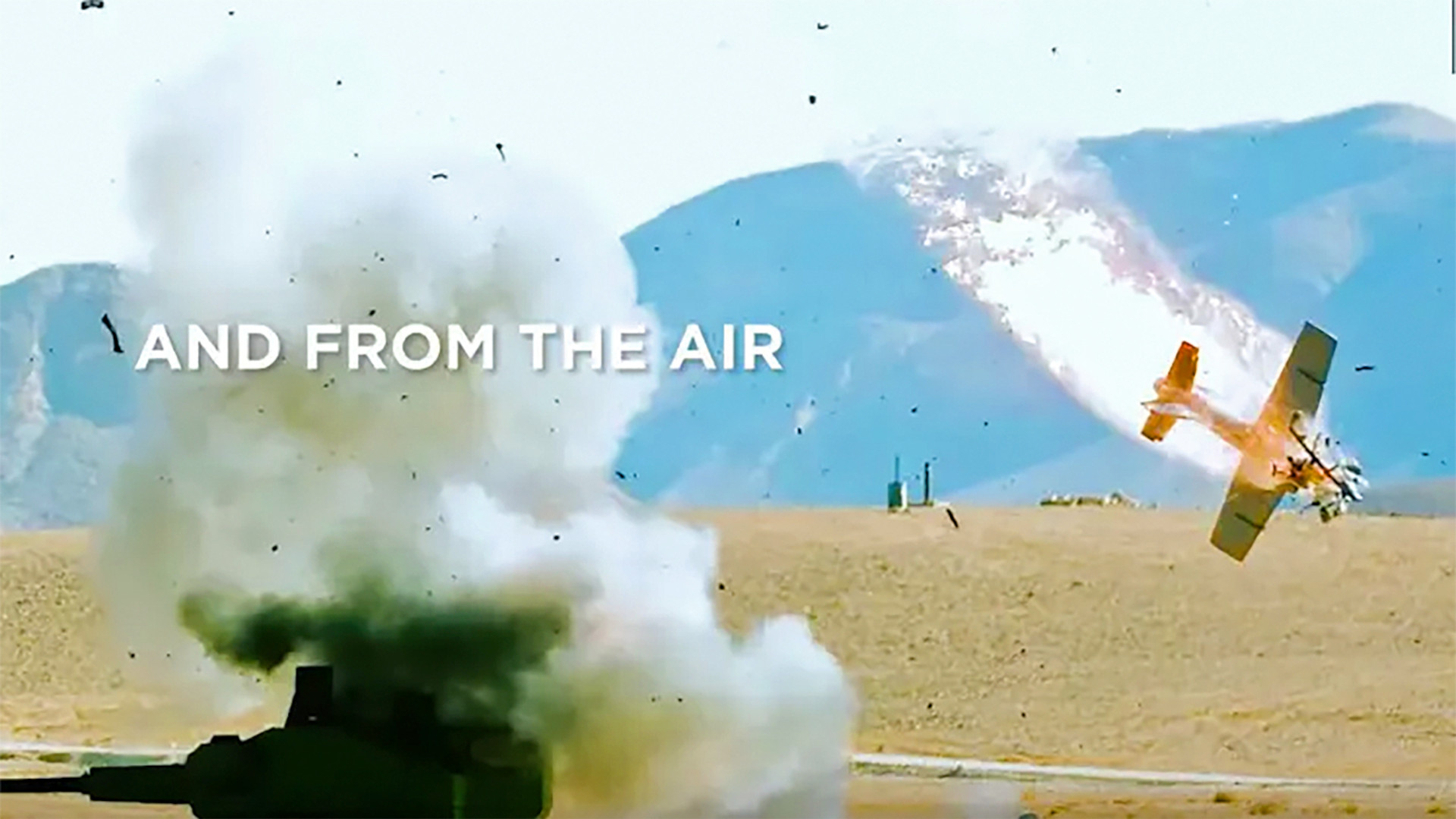Israeli defense contractor Rafael says it has developed a new version of its combat-proven Trophy active protection system (APS) that is better able to defeat top-down attacks. Increasing Trophy’s ability to engage threats attacking from above could be particularly valuable for swatting down hostile drones, including highly maneuverable first-person view kamikaze (FPV) types and ones designed to drop small munitions straight down on their targets. The War Zone previously laid out a detailed case for how hard-kill APSs like Trophy could help give tanks and other armored vehicles a critical additional layer of protection against these threats, which the war in Ukraine has brought fully into the public view.
Rafael publicly unveiled Trophy’s new top-attack defense capability today, which can be seen demonstrated in the video below, including against a target drone. The video also includes multiple clips from the conflict in Ukraine, including one captured via the camera on an FPV drone right before it hits its mark, as well as various flash points in the Middle East.

Trophy was first developed in the late 2000s and was originally primarily designed to defend against anti-tank guided missiles and other types of infantry anti-armor weapons like shoulder-fired rockets and rocket-propelled grenades. Trophy’s existing core components are an array of small radars and launchers pre-loaded with ‘hard-kill’ projectiles. The radars detect incoming threats and cue the launchers, which then fire their projectiles. Though a small explosive charge is used to propel them, the projectiles themselves are kinetic, being designed to destroy, or at least disrupt, whatever they hit through sheer force of impact.

“Rafael officials unveiled the [top-attack defense] upgrade in a briefing here last week held ahead of the AUSA [Association of the U.S. Army] arms exhibition in Washington next week, where the company will exhibit its wares,” according to a report from Defense News. “The company declined to specify how the upgrade works or when the capability was first introduced on Trophy, saying only the system had undergone numerous development cycles since first being fielded more than ten years ago.”
The imagery Rafael has now released highlighting Trophy’s new top-down defense capabilities does show pronounced explosive blasts. It is unclear whether this reflects the launch of additional kinetic interceptors, the use of an actual explosive charge to defeat incoming threats, and/or secondary explosions from successful interceptions. Regardless of how the improved system functions, it offers additional coverage against drones and other threats from above like anti-tank guided missiles with top-down attack capability.



The Israel Defense Forces (IDF) first began fielding Trophy on its Merkava tanks in 2009. The system, which is now in increasing service globally, including with the U.S. military, has since demonstrated its value in combat many times. The video below from fighting in the Gaza Strip in December 2023 offers a prime view of the system in action.
However, it has long been known that Trophy has certain limitations against threats approaching from steep downward angles, something Rafael itself has made no secret of in the past. The system “provides 360° protection in azimuth as well as extensive elevation coverage,” according to official marketing material.
The potential vulnerabilities that the limits to Trophy’s “elevation coverage” present have come more into view since Hamas’ large-scale terrorist attacks on southern Israel on October 7, 2023. The Palestinian terrorist group used drones to drop small munitions on top of Israeli Merkava tanks and other vehicles, as well as static defenses. It is unclear whether or not the Trophys on the Merkavas were in operation at the time of those attacks, but they still prompted new discussions about the system’s top-down defense deficiencies.
So-called “cope cage” type metal armor screens subsequently emerged on top of IDF Merkavas and other armored vehicles underscoring concerns about drones and other threats from above.

The Russian military was the first to employ this kind of armor and it has now become a staple on both sides of the ongoing war in Ukraine primarily to help protect against drone attacks. It has also begun to appear on vehicles (and even other assets like submarines) elsewhere globally, including now in China.
Threats posed by drones, including weaponized commercial types, are not new, as The War Zone routinely points out. The conflict in Ukraine has now fully driven this reality into the mainstream consciousness, especially when it comes to the ability to even lower-tier uncrewed weaponized aerial systems to wreak havoc on armored vehicles.
Rafael’s addition of new top-attack defense capabilities to Trophy reflects a parallel trend in the demand for counter-drone capabilities globally. The Pentagon just recently announced that defeating drones, an area where the U.S. military continues to lag behind, will be the focus of a new Replicator 2 rapid fielding initiative. The original Replicator effort has been focused on getting uncrewed systems into the hands of American forces.
The idea of using Trophy and other hard-kill APSs to provide an existing and relatively quick avenue for adding anti-drone defenses to tanks and other armored vehicles is also now new, as you can learn more about in detail in our past deep-drive on this exact topic. At the same time, it is important to note that APSs are not a silver bullet solution to drone threats, which look to be on the cusp of another major evolution, if not a revolution driven heavily by advances in artificial intelligence, the subject of another recent War Zone feature.
Layered defenses, including other systems mounted on vehicles and ones otherwise deployed around the battlespace, will be key to meeting current and future counter-drone requirements. This will be especially true when it comes to defeating large-volume attacks, including ones involving networked swarms. A counter-drone ecosystem that includes high-power laser and microwave directed energy weapons, laser dazzlers, and electronic warfare jammers, as well as traditional guns and surface-to-air missiles, is already emerging.
With all this in mind, Rafael’s new top-down defense upgrade for Trophy is not only logical, but is likely a sign of things to come from other APS manufacturers as critical demand for new and improved ways to defend tanks and other armored vehicles against drones keeps growing.
Contact the author: joe@twz.com
